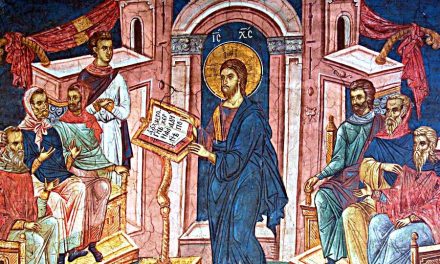Small children are not the only ones who routinely confuse the word “adultery” with “idolatry.” Even though I presume they know the difference, students in my Intro Bible course often mistakenly use one for the other. Whether it is a Freudian slip I dare not say, but as we discuss both in relation it becomes apparent that the two share more than merely a phonetic resemblance.
Adultery is the narrative pretext for this Sunday’s gospel reading, but in many ways idolatry is its thematic focal point. John speaks of an incident that interrupts Jesus’ daily agenda at the Temple: a woman caught in adultery is taken there to be stoned in the sight of the people and in the sight of God.
The act is one of divine sanction, carried out in order to preserve the holiness of the community with whom the Lord has chosen to dwell. The God of Israel is present in Zion and the God of Israel is holy. Recall the strict boundaries around Sinai as Moses went up the mountain to meet God: those who transgressed them—even the animals—had to be quarantined and stoned to death (Ex 19:10-13). When Aaron’s sons loaded their censers incorrectly in the Holy Place and so offered “unholy fire” to the Lord, “fire came out from the Presence of the Lord and consumed them, and they died before the Lord” (Lev 10:1-2). Likewise this transgression of one the “ten words” given to Moses, first and foremost among the Law, was seen not simply as a “moral lapse” or “an expression of vice” but as a toxic breach of the covenant of holiness to which the community was bound—a covenant that could prove lethal as well as life-giving. Such was the fear that drove the Scribes and Pharisees to put this woman to death before their place of worship.
Notice what Jesus is doing before the accusers break in upon the scene: he is teaching the people who have gathered there to listen. Jesus is offering to the people in words an account of who God is and what God wants for them when he is suddenly confronted with an alternative account, given not in words but in action, in the fulfillment of the Law’s prescriptions. John tells us this confrontation was a “test,” though perhaps “contest” might be a better word. The Scribes and Pharisees engage Jesus in a public agon in which both their reputations are placed on the line.
What is more, this test is meant not only to confront Jesus, but also to provide “some charge to bring against him.” It is this further purpose which reveals their true intent in zealously keeping the Law. It is not enough to accuse and convict one sinner at a time; they see the woman’s adultery as an opportunity to accuse and convict any who would oppose their understanding what of who God is and what God’s holiness requires. Their de-contamination of the community must include in its sweep any like Jesus who might contextualize or in any way relativize the prescriptions of the Law. And so these zealous Israelites make themselves the Lord’s adversary. They confront him in the courtyards of the holy city, and their mode of engagement is one of accusation.
How then does this confrontation evoke idolatry? What is at stake is nothing less than who God is and what it means to rightly worship him. Of course, the Scribes and Pharisees think they have it figured out. And to be fair, it is not as if their view is one of their own invention or imagining: they were not in it for themselves, but were merely following what they believed God told Moses to do. Yet here they are, acting the part of adversary and accuser: the two primary meanings of the name which the Bible assigns to the diabolical force which opposes his purposes in the world— Satan.
We are in no greater danger of idolatry than when we are satisfied that we have taken every possible measure to avoid it. We are in no greater danger of opposing God’s work in the world than when convince ourselves that we possess the formula for carrying it out.
So the Scribes and Pharisees ask Jesus, “so what do you say?” The question, when viewed from a certain angle, is utterly diabolical. It is the mocking question which the fallen angels ask when they have chewed up and spit out a soul created in God’s image and placed its wounded, contorted frame at the feet of the Creator: “what do you think of your ‘treasured possession’ now? Can you bear even to look at it?”
It is hard to know for whom the Lord must have grieved more: the Pharisees or the woman. Neither are holy, neither can rightly stand before the holy place. The woman has forgotten the proper dignity and purpose of her body (or likely been led to forget), and perhaps marred the lives of her husband and children in the process. It would trivialize the story merely to exonerate her on account of the Pharisees’ vindictiveness. Yet they are the ones who have forgotten God more completely, since they replaced his voice—that uncanny, unfathomable voice—with their own compulsions and mechanisms of security. Truly, what could the Lord have said in this situation?
Jesus gives the most profound response possible: he refuses to answer with words, and instead bends down and begins to write in the dust. What exactly he was writing John does not say, and I cannot believe the omission to be unintentional. It rouses our curiosity: if only we knew what he was writing, we could gain a better understanding of how Jesus responds to this situation. Yet our lack of understanding is precisely the point to which Jesus’ writing draws our attention: we do not know the divine judgment that the Lord was writing upon the dust of Mt. Zion.
We do know that he was writing in the dust though, which as countless commentators have pointed out, is a clear reference to the creation story of Genesis 2, in which God forms the human person from the dust and blows the breath of life into his nostrils. What Jesus is doing here, in other words, is an act of creation no less radical and no less ex nihilo than that which preceded time and space itself.
It is important to point out, I think, that Jesus is not simply countering “negativity” in this story and affirming the always-already present dignity of the woman whose mistake was not really all that bad, so long as you put it in the right perspective. No, the act of “writing in the dust” clearly indicates that (at least spiritually) both parties here are dead and in need of re-creation. The Pharisees are right that God is a holy God and so cannot dwell among those who are not ready to receive him. Yet their error, which is ultimately much greater than the adulteress’, is that they no longer recognize their own uncleanness and their own self-affirming delusions about who God is and what God wants. Their practice of the Law, rather than placing them before the inscrutable and consuming presence of YHWH, serves only to bolster their own sense of security and their own self-aggrandizement.
How Jesus must have frustrated them! “What’s he doing? He’s writing in the dirt. He’s stalling! Answer us already!!” And then the Lord looks up—only for a moment—and delivers the knockout blow: “let the one among you without sin be the first to throw a stone at her.” Jesus then goes back to his dirt-writing, as if to say “you have come here to destroy my creation, but I am making it new.” As Isaiah proclaims in the first reading, “I am doing a new thing.” Perhaps as a correlative we might dare to add, “and I am mighty enough to do so without requiring the destruction of the old.”
And so the people drop their stones and disperse. Here is the new creation manifested before our eyes. The adversaries and accusers have been sent away, and the Creator now speaks alone with his creature. Surely if the writing in the dust was an allusion to creation, this final exchange in the reading points us back to that fateful exchange between God and our first parents in Eden. There, in Genesis 3, God asks Adam and Eve where they have gone: “where are you?” Here, God asks the redeemed woman where her accusers are: ““Woman, where are they? Has no one condemned you?” The woman then is empowered to reply, surely through her own tears: “no one, sir.”
“Then Jesus said, ‘Neither do I condemn you. Go, and from now on do not sin any more.’” The Lord has revealed himself here as the Holy One of Israel: the One who cannot be reduced to human images or formulas, and the One whose power to re-create can overcome all of our attempts to replace him with the false gods we create to sanction our own lusts and fears. Let us pray that we may find ourselves one day alone with Him, having returned once more to the dust, and hear him ask us with victory in his voice: “where have all your accusers gone?”





Trackbacks/Pingbacks